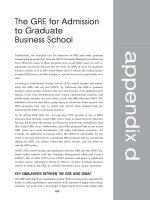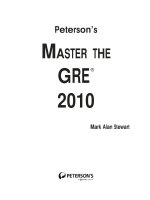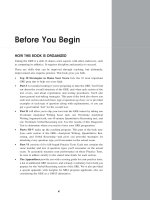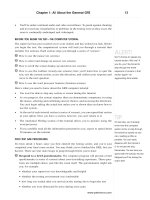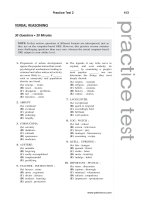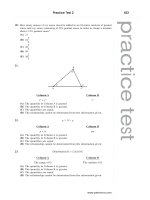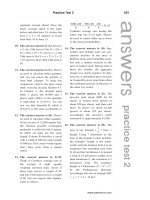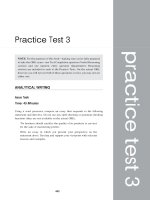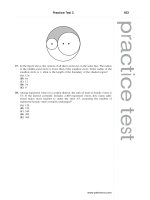Tài liệu Master the Gre 2010 - Part 28 docx
Bạn đang xem bản rút gọn của tài liệu. Xem và tải ngay bản đầy đủ của tài liệu tại đây (50.19 KB, 10 trang )
34. Dr. Kramer plans to invest $20,000 in an account paying 6% interest
annually. How much more must she invest at the same time at 3% so that
her total annual income during the first year is 4% of her entire
investment?
(A) $32,000
(B) $36,000
(C) $40,000
(D) $47,000
(E) $49,000
The correct answer is (C). Letting x equal the amount invested at 3%, you can
express Dr. Kramer’s total investment as 20,000 1 x. The interest on $20,000
plus the interest on the additional investment equals the total interest from both
investments. You can state this algebraically as follows:
0.06(20,000) 1 0.03x 5 0.04(20,000 1 x)
Multiply all terms by 100 to eliminate decimals, then solve for x:
6~20,000!13x 5 4~20,000 1 x!
120,000 1 3x 5 80,000 1 4x
40,000 5 x
She must invest $40,000 at 3% for her total annual income to be 4% of her
total investment ($60,000).
Beware: In solving GRE investment problems, by all means size up the question to
make sure your calculated answer is in the ballpark. But don’t rely on your intuition
to derive a precise solution. Interest problems can be misleading. For instance, in
attempting to solve the previous problem you might have guessed that Dr. Kramer
would need to invest more than twice as much at 3% than at 6% to lower the overall
interest rate to 4%, which is not true.
Problems of Rate of Production and Rate of Travel
A rate is a fraction that expresses a quantity per unit of time. For example, the rate at
which a machine produces a certain product is expressed this way:
rate of production 5
number of units produced
time
RATE OF PRODUCTION (WORK)
A simple GRE rate question might provide two of the three terms and then ask you for
the value of the third term. To complicate matters, the question might also require you
to convert a number from one unit of measurement to another.
Chapter 10: Math Review: Number Theory and Algebra 253
www.petersons.com
35. If a printer can print pages at a rate of 15 pages per minute, how many
pages can it print in 2
1
2
hours?
pages
Enter a number in the box.
The correct answer is (2250). Apply the following formula:
rate 5
no. of pages
time
The rate is given as 15 minutes, so convert the time (2
1
2
hours) to 150
minutes. Determine the number of pages by applying the formula to these
numbers:
15 5
no. of pages
150
~15!~150!5no. of pages
2,250 5 no. of pages
A more challenging type of rate-of-production (work) problem involves two or more
workers (people or machines) working together to accomplish a task or job. In these
scenarios, there’s an inverse relationship between the number of workers and the
time that it takes to complete the job; in other words, the more workers, the quicker
the job gets done.
A GRE work problem might specify the rates at which certain workers work alone and
ask you to determine the rate at which they work together, or vice versa. Here’s the
basic formula for solving a work problem:
A
x
1
A
y
5 1
In this formula:
• x and y represent the time needed for each of two workers, x and y, to complete
the job alone.
• The letter A represents the time it takes for both x and y to complete the job
working in the aggregate (together).
So each fraction represents the portion of the job completed by a worker. The sum of
the two fractions must be 1 if the job is completed.
PART IV: Quantitative Reasoning254
NOTE
In the real world, a team may
be more efficient than the
individuals working alone. But
for GRE questions, assume that
no additional efficiency is
gained this way.
www.petersons.com
36. One printing press can print a daily newspaper in 12 hours, while another
press can print it in 18 hours. How long will the job take if both presses
work simultaneously?
(A) 7 hours, 12 minutes
(B) 9 hours, 30 minutes
(C) 10 hours, 45 minutes
(D) 15 hours
(E) 30 hours
The correct answer is (A). Just plug the two numbers 12 and 18 into our work
formula, then solve for A:
A
12
1
A
18
5 1
3A
36
1
2A
36
5 1
5A
36
5 1
5A 5 36
A 5
36
5
or 7
1
5
Both presses working simultaneously can do the job in 7
1
5
hours—or 7 hours, 12
minutes.
RATE OF TRAVEL (SPEED)
GRE rate problems often involve rate of travel (speed). You can express a rate of travel
this way:
rate of travel 5
distance
time
An easier speed problem will involve a single distance, rate, and time.A tougher speed
problem might involve different rates:
• Two different times over the same distance
• Two different distances covered in the same time
In either type, apply the basic rate-of-travel formula to each of the two events. Then
solve for the missing information by algebraic substitution. Use essentially the same
approach for any of the following scenarios:
• One object making two separate “legs” of a trip—either in the same direction or as
a round trip
• Two objects moving in the same direction
• Two objects moving in opposite directions
Chapter 10: Math Review: Number Theory and Algebra 255
TIP
In problems involving rate of
work, use common sense to
narrow down answer choices.
If one worker’s rate is faster
than another’s, the combined
rate is twice as fast as a rate
somewhere between the two
individual rates.
www.petersons.com
37. Janice left her home at 11 a.m., traveling along Route 1 at 30 mph. At
1 p.m., her brother Richard left home and started after her on the same
road at 45 mph. At what time did Richard catch up to Janice?
(A) 2:45 p.m.
(B) 3:00 p.m.
(C) 3:30 p.m.
(D) 4:15 p.m.
(E) 5:00 p.m.
The correct answer is (E). Notice that the distance Janice covered is equal to
that of Richard—that is, distance is constant. Letting x equal Janice’s time, you
can express Richard’s time as x 2 2. Substitute these values for time and the
values for rate given in the problem into the speed formula for Richard and
Janice:
Formula: rate 3 time 5 distance
Janice: (30)(x) 5 30x
Richard: (45)(x 2 2) 5 45x 2 90
Because the distance is constant, you can equate Janice’s distance to Rich-
ard’s, then solve for x:
30x 5 45x 2 90
15x 5 90
x 5 6
Janice had traveled 6 hours when Richard caught up with her. Because
Janice left at 11:00 a.m., Richard caught up with her at 5:00 p.m.
38. How far in kilometers can Scott drive into the country if he drives out at
40 kilometers per hour (kph), returns over the same road at 30 kph, and
spends 8 hours away from home, including a 1-hour stop for lunch?
(A) 105
(B) 120
(C) 145
(D) 180
(E) 210
The correct answer is (B). Scott’s actual driving time is 7 hours, which you
must divide into two parts: his time spent driving into the country and his time
spent returning. Letting the first part equal x, the return time is what remains of
the 7 hours, or 7 2 x. Substitute these expressions into the motion formula for
each of the two parts of Scott’s journey:
Formula: rate 3 time 5 distance
Going: (40)(x) 5 40x
Returning: (30)(7 2 x)
5 210 2 30x
PART IV: Quantitative Reasoning256
TIP
Regardless of the type of
speed problem, start by setting
up two distinct equations
patterned after the simple
rate-of-travel formula
(r 3 t 5 d).
www.petersons.com
Because the journey is round trip, the distance going equals the distance
returning. Simply equate the two algebraic expressions, then solve for x:
40x 5 210 2 30x
70x 5 210
x 5 3
Scott traveled 40 kph for 3 hours, so he traveled 120 kilometers.
Problems Involving Overlapping Sets
Overlapping set problems involve distinct sets that share some number of members.
GRE overlapping set problems come in one of two varieties: single overlap and double
overlap. As you might guess, the latter variety is generally more difficult.
39. Each of the 24 people auditioning for a community-theater production is
an actor, a musician, or both. If 10 of the people auditioning are actors and
19 of the people auditioning are musicians, how many of the people
auditioning are musicians but not actors?
(A) 10
(B) 14
(C) 19
(D) 21
(E) 24
The correct answer is (B). You can approach this relatively simple problem
without formal algebra: The number of actors plus the number of musicians
equals 29 (10 1 19 5 29). However, only 24 people are auditioning. Thus, 5 of the
24 are actor-musicians, so 14 of the 19 musicians must not be actors.
You can also solve this problem algebraically. The question describes three
mutually exclusive sets: (1) actors who are not musicians, (2) musicians who are
not actors, and (3) actors who are also musicians. The total number of people
among these three sets is 24. You can represent this scenario with the following
algebraic equation (n 5 number of actors/musicians), solving for 19 2 n to answer
the question:
~10 2 n!1n 1~19 2 n!524
29 2 n 5 24
n 5 5
19 2 5 5 14
Chapter 10: Math Review: Number Theory and Algebra 257
www.petersons.com
40. Adrian owns 60 neckties, each of which is either 100% silk or 100%
polyester. Forty percent of each type of tie are striped, and 25 of the ties
are silk. How many of the ties are polyester but not striped?
(A) 18
(B) 21
(C) 24
(D) 35
(E) 40
The correct answer is (B). This double-overlap problem involves four distinct
sets: striped silk ties, striped polyester ties, non-striped silk ties, and non-striped
polyester ties. Set up a table representing the four sets, filling in the information
given in the problem, as shown in the next figure:
striped
non-striped
silk polyester
25 35
40%
60%?
Given that 25 ties are silk (see the left column), 35 ties must be polyester
(see the right column). Also, given that 40% of the ties are striped (see the
top row), 60% must be non-striped (see the bottom row). Thus, 60% of 35
ties, or 21 ties, are polyester and non-striped.
PART IV: Quantitative Reasoning258
TIP
Use a Venn diagram
(overlapping circles) or table
to organize the information in
an overlapping-set problem
and to help you visualize the
solution.
www.petersons.com
SUMMING IT UP
• Make sure you’re up to speed on the definitions of absolute value, integers,
factors, and prime numbers to better prepare yourself for the number theory and
algebra questions on the GRE Quantitative Reasoning section.
• Use prime factorization to factor composite integers.
• GRE questions involving exponents usually require that you combine two or more
terms that contain exponents, so review the basic rules for adding, subtracting,
multiplying, and dividing them.
• On the GRE, always look for a way to simplify radicals by moving what’s under
the radical sign to the outside of the sign. Also, make sure you know the rules for
combining radical terms using the four basic operations.
• Most algebraic equations you’ll see on the GRE exam are linear. Remember the
operations for isolating the unknown on one side of the equation. Solving alge-
braic inequalities is similar to solving equations: Isolate the variable on one side
of the inequality symbol first.
• Weighted-average problems and currency problems can be solved in a similar
manner by using the arithmetic mean formula.
• Mixture and investment problems on the GRE can be solved using what you’ve
learned about proportion and percentage questions. Rate of production and travel
questions can be solved using the strategies you’ve learned about fraction
problems.
Chapter 10: Math Review: Number Theory and Algebra 259
www.petersons.com
Math Review:
Geometry
OVERVIEW
• Lines and angles
• Triangles
• Quadrilaterals
• Circles
• Polygons
• Cubes and other rectangular solids
• Cylinders
• Coordinate geometry—the xy-plane
• Summing it up
In this chapter, you’ll first review the following concepts—all of which involve
plane geometry:
• relationships among angles formed by intersecting lines
• properties of any triangle
• the Pythagorean theorem
• characteristics of special right triangles
• properties of isosceles and equilateral triangles
• properties of and differences among squares, rectangles, parallelograms,
and trapezoids
• properties of circles
• arcs and their relationships to other features of a circle
• relationships between circles and tangent lines
• relationships created by combining circles with other geometric figures
• properties of polygons (including those with more than four sides)
• properties of solids (cubes and other rectangular solids, and cylinders)
Later in the chapter, you’ll review the basics of coordinate geometry. These
basics include the following:
• features and characteristics of the xy-plane
• defining and plotting points and lines on the xy-plane
chapter 11
261
• applying the midpoint and distance formulas to problems involving lines and
lines segments
• plotting and defining two-dimensional figures (e.g., triangles and rectangles) on
the xy-plane
As in Chapters 9 and 10, the review in this chapter focuses strictly on what you need
to know for the GRE and provides one or two GRE-style questions for each reviewed
concept.
LINES AND ANGLES
Lines and line segments are the basic building blocks for most GRE geometry
problems. A GRE geometry question might involve nothing more than intersecting
lines and the angles they form. To handle the question, just remember four basic rules
about angles formed by intersecting lines:
Vertical angles (angles across the vertex from each other and formed by the same
two lines) are equal in degree measure, or congruent (≅). In other words, they’re
the same size.
If adjacent angles combine to form a straight line, their degree measures total
180. In fact, a straight line is actually a 180° angle.
If two intersecting lines are perpendicular (⊥) to each other, they form right (90°)
angles.
The sum of the measures of all angles where two or more lines intersect at the
same point is 360° (regardless of how many angles are involved).
Note that the symbol (≅) indicates that two geometric features are congruent, meaning
that they are identical (the same size, length, degree measure, etc.). The equation
AB ≅ CD means that line segment AB is congruent to line segment CD. The two
equations ∠A ≅∠B and m∠A 5 m∠B are two different ways of symbolizing the same
relationship: that the angle whose vertex is at point A is congruent (equal in degree
measure, or size) to the angle whose vertex is at point B. (The letter m symbolizes
degree measure.)
Angles Formed by Intersecting Lines
When two or more lines intersect at the same point, they form a “wheel-spoke” pattern
with a “hub.” On the GRE, “wheel-spoke” questions require you to apply one or more
of the preceding four rules.
PART IV: Quantitative Reasoning262
www.petersons.com
